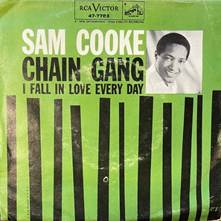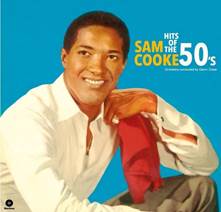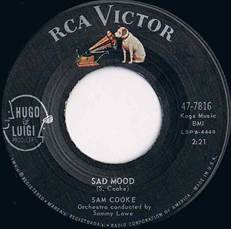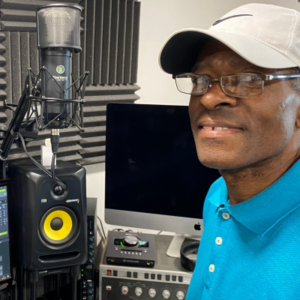After his exit from Keen Records, Sam Cooke must have been relieved to be at RCA Victor, an important major in the industry, where he would be able to explore his ideas about developing as a cross-over artist. The reality was harsh, however. RCA put out a single in early 1960, “Teenage Sonata”/ “If You Were The Only Girl”, pairing a dramatic teenage love song with a classic version of an old song written for a musical at the Alhambra Theatre in London in 1916. It failed to sell. Cooke’s new producers Hugo and Luigi then came up with “You Understand Me”/ “I Belong To Your Heart” in April, which was completely overwhelmed by an April release from Keen Records. “Wonderful World” had been recorded at Keen in March 1959 but was not released until April 1960, probably to coincide with the second RCA Victor release. It that was the plan, it certainly worked! “Wonderful World” peaked at number twelve on the Billboard Hot 100 Singles Chart and climbed to number two on the Billboard R&B Singles Chart. It also sold well in Europe, achieving gold certification from the BPI in the UK and platinum status in Spain. Not a very good start for RCA Victor or Sam Cooke, but an outstanding result for Keen.
“Cooke’s Tour“ was the fourth studio album of Sam Cooke’s career and marked his first album project with RCA Victor. Recorded in New York City at RCA Victor’s Studio A from 2nd to 3rd March 1960, it was released in May 1960. The album was produced by Hugo Peretti and Luigi Creatore, with Glenn Osser serving as arranger and conductor.

Conceived as a concept album, “Cooke’s Tour” takes listeners on a musical “tour” around the world, with each track reflecting a different cultural or geographical influence. The arrangements are polished and lush, consistent with RCA’s production aesthetic of the time. Glenn Osser’s orchestrations provided the album with a rich, international flavour, framing Cooke’s vocals in a tapestry of strings, woodwinds, and percussion. This new sound marked a stylistic departure from Cooke’s earlier gospel-infused and raw R&B recordings at Keen Records, signalling a clear move towards establishing him as a sophisticated, global entertainer, who could cross over into the White record market.
The album blends traditional Pop, Soul, Rhythm & Blues, and vocal Jazz. Each song features Cooke’s vocals supported by full orchestral arrangements. The instrumentation is cinematic and expansive, reinforcing the album’s travel-inspired concept. Glenn Osser, the classically trained composer and conductor, was the first of his kind to collaborate with Cooke during his tenure at RCA Victor.
The twelve tracks vary in tempo and mood, showcasing Cooke’s vocal versatility. Up-tempo numbers such as “Far Away Places” and “Bali Ha’i” deliver rhythmically bright arrangements, while mid-tempo selections like “The Japanese Farewell Song” and “Galway Bay” offer smooth, melodic charm. Slow ballads, including “London by Night” and “The House I Live In”, are characterised by rich orchestration and emotionally expressive vocal delivery.
All twelve tracks on “Cooke’s Tour” were composed by others, reflecting a broad international palette suited to the album’s concept. “Far Away Places” was written by Joan Whitney Kramer and Alex Kramer, “Under Paris Skies” by Hubert Giraud, Jean Dréjac, and Kim Gannon, and “South of the Border (Down Mexico Way)” by Jimmy Kennedy and Michael Carr. “Bali Ha’i”, from the musical South Pacific, was composed by Richard Rodgers and Oscar Hammerstein II, while “The Coffee Song (They’ve Got an Awful Lot of Coffee in Brazil)” was penned by Bob Hilliard and Dick Miles. “Arrivederci, Roma (Goodbye to Rome)” was the work of Renato Rascel and Carl Sigman.
On Side Two of the album, “London by Night” was written by Carroll Coates, “Jamaica Farewell” by Irving Burgie, and “Galway Bay”, a traditional Irish ballad, by Dr Arthur Colahan. “Sweet Leilani” was composed by Harry Owens, “The Japanese Farewell Song” by Yoshida Hasegawa and Freddy Morgan, and “The House I Live In” by Earl Robinson and Lewis Allen.
A number of accomplished studio musicians contributed to the sessions. Clifton White (guitar) and Lloyd Trotman (double bass) were prominent figures on the New York session scene. Bunny Shawker played drums, while piano duties were shared between Hank Jones and Morris Wechsler, both highly respected Jazz and Pop pianists. Flautists Joe Small and Jerome Weiner added woodwind textures that enhanced the album’s atmospheric tone.
The string section was especially strong, featuring violinists Hinda Barnett, James Bloom, Felix Giglio, and Harry Urbont, violists David Mankovitz and Isadore Zir, cellist Ray Schweitzer; and harpists Abe Rosen and Gloria Agostini. Together, they contributed significantly to the album’s orchestral elegance.
Engineering was overseen by Ray Hall, whose meticulous work ensured the recordings met RCA’s high production standards. His mixing achieved a clear balance between Cooke’s smooth, expressive vocals and the detailed instrumentation, adding to the album’s refined and cinematic sound.
Although “Cooke’s Tour” did not chart on the Billboard 200 Albums Chart, nor receive any RIAA certifications, it was an important artistic step. It helped reposition Sam Cooke as a crossover artist, expanding his audience beyond Gospel and R&B fans.
In retrospect, “Cooke’s Tour” stands as a carefully-crafted showcase of Sam Cooke’s vocal sophistication and cross-genre potential. While not a commercial success, it marked his entry into the Adult Pop sphere and hinted at the artistic depth he would explore in later albums. The record serves as a bridge between his Gospel-Soul roots and the visionary, socially conscious music that would come to define the next phase of his career.
A third Sam Cooke single was released in July 1960 by RCA Victor, and this time they hit the jackpot. “Chain Gang” marks a significant commercial and artistic milestone in Sam Cooke’s career. It was his first major hit following his move from Keen Records to RCA, and it showcased his ability to blend socially conscious themes with mass-market pop appeal.
In the United States, “Chain Gang” achieved major chart success, peaking at number two on the Billboard Hot 100 Singles Chart week-ending 29th August 1960 and number two on the Billboard R&B Singles Chart week-ending 26th September 1960. In the United Kingdom, it became Cooke’s first major hit; the single charted to number nine on the Official UK Pop Singles Chart, 5th September 1960.

Despite its popularity and million-selling status, “Chain Gang” was not officially certified by the RIAA or BPI at the time. (Note: The British Phonographic Industry [BPI] introduced formal certification in 1973). However, historical sales and impact suggest that it would have qualified for at least silver certification under modern UK standards.
Lyrically, “Chain Gang” is a striking fusion of pop melody and subtle social commentary. The song was inspired by Cooke’s real-life encounter with a group of prison labourers during a tour stop in Georgia. It vividly portrays the hardship of incarcerated workers through its chant-like chorus and rhythmic “hoo ahh” background vocals, echoing the sound of a chain gang at work.
While not overtly political, the track draws attention to the harsh realities of the American penal system and, by extension, the broader racial and economic disparities of the era. It marks one of Cooke’s earliest ventures into socially aware songwriting, a direction he would explore more explicitly in “A Change Is Gonna Come” (1964).
“Chain Gang” was recorded at RCA Victor Studio A in New York City during Spring 1960, under the production of Hugo Peretti and Luigi Creatore.
The session featured top-tier studio musicians, including Clifton White (guitar), Lloyd Trotman (double bass), Bunny Shawker (drums), with Joe Small and Jerome Weiner probably contributing (woodwinds).
The arrangement, cleverly crafted by Sammy Lowe, combined a steady rhythmic pulse with Cooke’s smooth lead vocals, resulting in a track that was both socially resonant and radio-friendly. The backing vocalists created the rhythmic call-and-response effect central to the song’s theme.
“Chain Gang” was pivotal in transforming Cooke’s image from a Gospel-rooted Soul singer to a mainstream international artist. Its success in both the US and the UK laid the foundation for future international hits like “Cupid” (1961), “Bring It On Home to Me” (1962), and “Twistin’ the Night Away” (1962).
With its crossover appeal, melodic strength, and quiet yet powerful commentary, “Chain Gang” stands as one of Cooke’s most important recordings, musically, culturally, and historically.
Released in August 1960, “Hits of the 50’s” was Sam Cooke’s fifth studio album and his second release on the RCA Victor label. The album was once again recorded at RCA Victor Studio A in New York City, continuing the polished production style initiated on “Cooke’s Tour”, which had been released earlier the same year.
“Hits of the 50’s” is a covers album for which Sam Cooke interprets a selection of well-known songs from the 1950s that had previously been popularised by other major recording artists. These include songs originally made famous by artists such as Nat King Cole, Frank Sinatra, Tony Bennett, and Eddie Fisher, among others. Rather than imitate the original versions, Cooke brings his own vocal charm, smooth phrasing, and Soul-infused nuance to the material, reimagining them through his distinctive lens.

His interpretations are elegant and restrained, demonstrating not only his versatility but also his ambition to establish himself as a crossover artist capable of handling adult pop standards with sophistication and style. While the album does not delve into his gospel or rhythm and blues roots, it shows Cooke’s sensitivity to melody and phrasing in a more mainstream pop setting.
The album was produced once more by Hugo Peretti and Luigi Creatore. The arrangements and conducting were managed by Glenn Osser, whose lush orchestral approach shaped the sonic character of the album. Osser, a classically trained musician, brought sweeping string arrangements, woodwinds, and gentle percussion to complement Cooke’s smooth vocal style.
Studio musicians featured on the album were among the top session players in New York at the time. Though specific line-up details for each session are not widely published, RCA Victor frequently employed a pool of accomplished instrumentalists including Clifton White (guitar), Lloyd Trotman (double bass), and Hank Jones or Morris Wechsler (piano). These musicians are likely to have contributed to the refined and cinematic atmosphere that defined RCA’s early 1960s Pop productions.
The twelve tracks selected for the album reflect a curated homage to some of the most enduring pop ballads of the 1950s. Among the songs featured are “Mona Lisa” (originally by Nat King Cole), “Venus” (made popular by Frankie Avalon), “Unchained Melody” (recorded by several artists, including Al Hibbler and Roy Hamilton), “The Great Pretender” (originally by The Platters), “Cry” (made famous by Johnnie Ray), and “Only Sixteen” – notably a re-recording of Cooke’s own 1959 hit, offering a smoother, more polished rendition.
While the album does not follow a conceptual narrative like “Cooke’s Tour”, it presents a cohesive artistic direction, positioning Cooke within the sophisticated Adult Pop mainstream of the era. The orchestral backing, formal song structures, and nostalgic tone all contribute to a seamless listening experience that is rooted in the post-war American popular songbook.
Although “Hits of the 50’s” did not achieve significant commercial success and did not chart on the Billboard 200 Albums Chart, it remains a noteworthy entry in Cooke’s discography. It highlights his commitment to crossing musical boundaries and broadening his appeal beyond the Rhythm and Blues market. The album is a clear example of RCA Victor’s strategy to package Cooke as a polished and cosmopolitan entertainer, suitable for mainstream radio and international audiences.
In retrospect, the album may not represent the most innovative or iconic phase of Cooke’s career, but it is essential for understanding his artistic development and transitional years. It showcases his ability to reinterpret well-known material with elegance and emotional restraint, offering early signs of the mature artistry that would emerge more powerfully in later works like “Night Beat” (1963) and “Ain’t That Good News” (1964).
Sam Cooke’s sixth studio album, released in February 1961, was called “Sam Cooke” in the USA and “Swing Low” in the UK.. It was recorded in New York City at the RCA Victor Recording Studios on September 9th and 10th, 1960, with production handled as usual by the team of Hugo & Luigi. The album did not chart on the Billboard 200 Albums Chart, making it a lesser-known gem in Cooke’s RCA discography, one that beautifully bridges his Gospel roots and Pop-Soul experiments. Despite its lack of commercial chart success, “Swing Low” remains notable for featuring the major hit single “Chain Gang”.

A comparative analysis of Sam Cooke’s “Swing Low” (RCA Victor, 1961) and his earlier Keen Records recordings reveals distinct shifts in artistic quality, production approach, and stylistic direction. Cooke’s Keen Records output, including his major hits “You Send Me”, “Win Your Love for Me”, and “Only Sixteen”, exhibited innovation and crossover appeal. These recordings showcased a fresh blend of Gospel-rooted vocals and Pop sensibility. However, Keen’s limited production budgets resulted in lean, minimal arrangements that were driven by rhythm guitar, light percussion, and a focus on Cooke’s vocal delivery. While sonically modest, this simplicity worked to Cooke’s advantage, emphasising his voice and charismatic presence.His phrasing retained the emotional gravity of Gospel music, even in love songs and ballads, and the tension between sacred and secular gave the Keen recordings a new and unique artistic edge.
By contrast, “Swing Low”, produced under RCA’s more sophisticated studio system, features lush orchestration, choral backing, and refined sound engineering. The album leans heavily into Gospel and traditional spirituals, filtered through a Pop-oriented lens, thus continuing the Keen experimentation. But the album often lacks the raw emotional immediacy of the Keen-era material. The more formal RCA arrangements arguably dilute some of the feeling that made Cooke’s earlier work so compelling.
The album features prominent session musicians, including Clifton White, Don Arnone, Everett Barksdale, and Al Chernet on guitar, with George Barnes contributing specifically to the track “Chain Gang”. Legendary jazz bassist Milt Hinton provides upright bass throughout the album. Drummers Jimmy Crawford and Bunny Shawker add rhythmic depth, while jazz pianist Hank Jones contributes elegant piano parts. Seldon Powell’s saxophone work adds a subtle, soulful texture to the arrangements.
The album also includes an orchestral ensemble that adds depth and sophistication. The violin section features Hinda Barnett, Fred Fradkin, Archie Levin, Harry Lookofsky, Ben Miller, David Nadien, and Sylvan Shulman. Al Brown plays viola, and George Ricci performs on cello, providing rich harmonic support. Trumpet players include Steve Lipkins and Leon Marian, with Ernie Royal featured on select tracks. The trombone section includes Henderson Chambers, Albert Godlis, and Frank Saracco.
The majority of the musicians featured on “Swing Low” were part of New York City’s elite studio scene, which was RCA Victor’s operational base. Session players like Milt Hinton, Hank Jones, Seldon Powell, and George Barnes regularly collaborated on recordings for RCA, Columbia, and Verve. Many of the string and brass players, such as David Nadien, Harry Lookofsky, and Ernie Royal, were part of NYC’s orchestral and Broadway circles, helping to achieve the album’s refined, technically precise sound.
The primary arranger and conductor for the album was Sammy Lowe, known for the lush style of his orchestrations that blended well with Gospel and Pop music. Lowe was a frequent RCA collaborator and played a significant role in shaping the polished sound of Cooke’s early RCA recordings. Glenn Osser, an experienced arranger of Pop songs and standards, conducted the standout single “Chain Gang”, contributing to one of Cooke’s biggest crossover hits.
The five most significant songs on the album are outlined below.
“Swing Low, Sweet Chariot”, the title track, is a spiritual classic delivered with reverence. Cooke’s vocal phrasing is smooth and understated, supported by rich orchestration and a subtle choir, transforming a traditional hymn into a soulful, introspective listening experience.
“I’m Just a Country Boy” is a gentle, folksy ballad that showcases Cooke’s softer side. His delicate vocal tone brings out the quiet melancholy in the lyrics.
“They Call the Wind Maria”, originally from the Broadway musical Paint Your Wagon, reflects the album’s crossover ambitions, with Cooke re-interpreting American musical theatre through his soulful style.
“All the Way” is a cover of the standard popularised by Frank Sinatra. This track highlights Cooke’s ability to interpret classic Pop ballads with emotional depth and effortless phrasing.
“Chain Gang” is stylistically more aligned with his Pop-Soul hits. The track was recorded earlier and released as a single, before being added to the album. It became a breakout hit, peaking at number two on the Billboard Hot 100 Singles Chart and also on the Billboard R&B Singles Chart. Its rhythmic grunt-chorus and socially-conscious theme added grit and relevance to the otherwise spiritual album.
The song was inspired by a real-life encounter with prisoners performing hard labour on a roadside and marked Cooke’s growing engagement with civil rights themes. Musically, it blends elements of Pop, Soul, and Gospel, featuring Cooke’s smooth vocals and rhythmic background grunts that evoke the physical toll of the labour described. The percussive beat reinforces the relentless grind of the chain gang, amplifying the song’s emotional weight.
Lyrically, “Chain Gang” humanises incarcerated individuals, portraying them as weary yet dignified men longing for freedom and connection. Lines like “My work is so hard / Give me water, I’m thirsty” offer glimpses into their suffering. Although not overtly political, the song critiques systemic injustice by highlighting the humanity of those subjected to prison labour, many of whom were Black men in the American Southern States. Its commercial success demonstrated the ability of socially conscious music to resonate with mainstream audiences. It helped solidify Cooke’s status as a crossover artist and laid the foundation for the socially- aware Soul music that followed.
“Chain Gang” was one of three Sam Cooke compositions on the “Swing Low”/ “Sam Cooke” album; the other two were co-written with James W. Alexander, his friend from his time in Los Angeles with the Soul Stirrers. The first is “If I Had You”. The song is a gentle expression of romantic longing. Its restrained arrangement allows Cooke’s warm, yearning delivery to take centre stage. The second is “You Belong to Me”, which offers a more assured declaration of love, with a smooth, polished backing that reflects RCA’s early-1960s production style. Though secular in theme, both tracks carry Gospel-tinged sincerity in Cooke’s phrasing, illustrating his gift for blending emotional intimacy with refined pop-soul craftsmanship.
In the context of “Swing Low”/ “SC”, these three tracks (alongside Johnnie Taylor’s composition “Pray”) add a personalised, modern element to an album otherwise steeped in traditional material.
In conclusion, “Swing Low” is a Gospel-infused Pop album that reflects Sam Cooke’s effort to honour his spiritual roots while embracing the orchestrated production style of early 1960s RCA Victor recordings. It showcases Cooke’s versatility as a vocalist and interpreter of traditional material. The arrangements, primarily conducted by Sammy Lowe, are smooth and dignified, often featuring strings, choral backing, and gentle rhythm sections, creating a blend of sacred spirituals and crossover Soul. The result is an album that bridges Gospel, Folk, and Easy Listening, appealing to both secular and church-going audiences of the time.
“Swing Low” is a reflective, spiritual, and highly produced album that stands apart in Sam Cooke’s discography. It may not possess the raw urgency of his Keen recordings or the creative autonomy found in later albums like “Night Beat”, but it remains an important record. It highlights Cooke’s spiritual roots, his adaptability as a performer, and his ability to bring emotional grace to a more formal, mainstream musical setting.

Released on 8th November 1960 as the follow-up single to his major hit “Chain Gang”, Sam Cooke’s “Sad Mood” marked a stylistic shift towards a more orchestrated and romantic ballad format. Whereas “Chain Gang” blended social commentary with rhythmic grit, “Sad Mood” presents Cooke in a refined, crooner-like mode, aligning more closely with the Pop ballad tradition of the early 1960s. Both songs were written by Sam Cooke, with Sammy Lowe conducting arrangements and Hugo Peretti and Luigi Creatore in charge of music production.
“Sad Mood” was recorded at the same recording studios as “Chain Gang”, but the follow-up single features lush string arrangements, a gentle rhythm section, and restrained backing vocals. The orchestration, typical of RCA’s polished house style, frames Cooke’s voice with sweeping violins and soft brass touches, creating a smooth, intimate atmosphere. The arrangement allows the vocal to remain central, but the production is more elaborate than it was for his earlier Keen Records work, signalling the label’s intention to position Cooke firmly within the mainstream Pop market.
Cooke delivers the song with measured restraint, his phrasing deliberate and controlled. His tone is warm and plaintive, embodying the melancholy of the lyric. While the delivery lacks the improvisational looseness of his Gospel-rooted performances, it demonstrates his versatility and ability to inhabit a more formal, Pop-oriented vocal style without sacrificing emotional sincerity.
The musicians at the recording session who played on the track were Clifton White (guitar), David Francis (drums), Milt Hinton (bass guitar), and Ernie Hayes (piano). A string ensemble (multiple violinists) and the backing vocalists are uncredited.
The song’s narrative centres on heartbreak and emotional vulnerability. The protagonist reflects on lost love, his sadness conveyed through simple but evocative lines. The lyric avoids elaborate metaphor, instead relying on direct, heartfelt sentiment, a hallmark of many early 1960s Pop ballads. The emotional core lies in its universality, making it accessible to a wide audience. Coming immediately after the success of “Chain Gang”, “Sad Mood” illustrates Cooke’s dual commercial strategy: maintaining relevance in the Pop charts through polished ballads while still recording material with Rhythm & Blues and Gospel inflections. This shift towards sophisticated Pop mirrors the career path of Nat King Cole, who successfully combined Black vocal traditions with mainstream Pop orchestration.
Although “Sad Mood” did not achieve the same level of chart success as “Chain Gang”, it was a respectable hit, making its way to number twenty-nine on the Billboard Hot 100 Singles Chart week-ending 5th December 1960 and number twenty-three on the Billboard R&B Singles Chart week-ending 19th December 1960, further establishing Cooke’s presence in the cross-over market. In retrospect, the single stands as a good example of RCA’s early shaping of Cooke’s sound, aiming to place him within a Pop ballad tradition that sometimes softened the raw immediacy of his earlier work, yet showcased his adaptability and mastery of diverse vocal idioms.
“Sad Mood” is a tender, string-laden ballad that contrasts sharply with the rhythmic drive and social commentary of “Chain Gang”. It reflects both Sam Cooke’s artistic range and the influence of RCA Victor’s production style during his early years with the label. While it may not be as socially resonant as its predecessor, it remains an important marker in his discography, capturing a moment when Cooke was refining his image as not only a Soul innovator but also a sophisticated interpreter of mainstream Adult Pop ballads.
Sam Cooke’s seventh studio album, “My Kind of Blues”, was recorded in New York between the 19th and 20th of May 1961 and released during October 1961. The project was produced by Hugo & Luigi, with musical arrangements and strings conducted by Sammy Lowe, a distinguished African American trumpeter and arranger. The album’s style ranges across Rhythm & Blues, Soul, and Jazz-inflected Pop, adding several more elements to Cooke’s artistic direction.
“My Kind of Blues” pivots towards a refined collection of Jazz and Blues standards. Recorded at RCA Studio A in New York City, it features a tight band and horn section, providing the perfect backdrop for Cooke’s smooth tenor voice, as he interprets classics by Gershwin, Ellington, and others.
The album represents a clear stylistic expansion for Cooke. It is not a traditional Blues album, but rather a demonstration of his vocal versatility and interpretative skill in a more orchestrated and arranged setting. Though it may lack the raw emotion of his earlier Keen Records work or the personal depth of later albums like “Night Beat”, “My Kind of Blues” is widely regarded as a hidden gem, a mature and elegant entry in his RCA catalogue.

The album opens with “Don’t Get Around Much Anymore”, a Duke Ellington classic. Cooke offers a relaxed and urbane interpretation, bringing a laid-back charm to this swing-era standard. His phrasing is smooth and slightly playful, blending Jazz timing with Pop appeal.
“Little Girl Blue” follows with a tender and restrained performance. Sparse instrumentation allows Cooke’s emotional sensitivity to shine through, demonstrating his affinity for torch songs.
“Nobody Knows You When You’re Down and Out” is a standout, where Cooke’s soulful, mournful tone brings dignity to the lyrics. The warm horn arrangements add emotional depth and resonance.
In “Out in the Cold Again”, Cooke maintains the album’s melancholic atmosphere. His smooth yet sorrowful delivery reveals his ability to communicate heartache with elegance and nuance.
The Gershwin number “But Not for Me” introduces a lighter, more charming tone. Cooke’s subtle swing and vocal finesse maintain emotional honesty while softening the mood.
“Exactly Like You” brightens the pace with an upbeat, rhythmic bounce. Cooke navigates big-band styling with ease, demonstrating his comfort with Jazz phrasing and tempi.
On “I’m Just a Lucky So and So”, Cooke adopts a mellow, conversational tone reminiscent of Nat King Cole. It’s a laid-back, bluesy interpretation delivered with depth and control.
The album closes with “The Song Is Ended (But the Melody Lingers On)”, a wistful and reflective piece. Cooke delivers it with grace and poise, bringing the album to a quiet, thoughtful conclusion.
There are four more tracks on the album that stand apart in terms of their origins. “Since I Met You Baby” was written by Texas Blues pianist Ivory Joe Hunter and recorded by him for Atlantic Records in 1956. “Baby Won’t You Please Come Home” was co-written by Charles Warfield and Clarence Williams and recorded by Bessie Smith for Columbia in 1923. “Trouble In Mind” is a song written by Richard M. Jones, a Jazz pianist from New Orleans, who recorded it for Bluebird Records in 1936. Finally, “You’re Always On My Mind” is the work of J.W. Alexander, a member of the Pilgrim Travelers and a friend of Sam Cooke from the Gospel tradition. They wrote some songs together.
“Since I Met You Baby” receives a Soul-infused treatment, with Cooke smoothing out the song’s Bluesier edges in an intimate and almost confessional manner.
“Baby, Won’t You Please Come Home” taps into Cooke’s Gospel sensibilities. His pleading vocal is emotionally charged, supported by a slow tempo and rich brass backing.
In “Trouble in Mind”, Cooke chooses understatement over dramatics, allowing the sorrow of the lyrics to emerge through restrained and subtle phrasing.
“You’re Always on My Mind” is a lesser-known but emotionally warm track delivered in a slow-swing style, showcasing the sincerity and richness of Cooke’s voice.
These four songs are firmly rooted in the Black musical traditions of Blues and Gospel. Two date back to the era of Race Records. Cooke spent much of his time in New York recording songs from very different sources, but now he casts his gaze over four songs that offered him something special, something from nearer home, that pointed in a new direction that he continued to explore over the next three years.
Cooke delivers each song with his distinctive blend of soul, control, and emotional nuance. The musical arrangements and orchestral conducting were again handled by Sammy Lowe, an arranger known for his work across Jazz as well as Pop recordings. The album was again produced by the well-known RCA team of Hugo & Luigi, who were instrumental in shaping its smooth and polished sound.
Hank Jones played piano. He was one of the most revered jazz pianists of his time, admired for his tasteful, elegant playing and harmonic sophistication. Milt Hinton, one of the most recorded bassists in American music history, provided the upright bass, bringing rhythmic finesse and a deep, resonant groove to the sessions. Guitar duties were shared by Clifton White, Don Arnone, Everett Barksdale, and Al Chernet, all seasoned studio guitarists who were active across many New York recording sessions in the 1950s and ’60s. Jimmy Crawford and Bunny Shawker performed on drums, offering subtle, versatile percussion that supported the album’s restrained and refined tone.
The strings and brass ensemble featured some of the city’s top classical and crossover musicians. Violinists included Hinda Barnett, Fred Fradkin, Archie Levin, Harry Lookofsky, Ben Miller, David Nadien, and Sylvan Shulman, a highly skilled group often heard in RCA’s orchestral recordings. Al Brown performed on viola, while George Ricci, brother of violinist Ruggiero Ricci, contributed his talents on cello. Ricci was widely regarded as one of the finest classical cellists active in studio work. The trumpet section featured Steve Lipkins and Leon Marian, with Ernie Royal appearing on selected tracks. The trombone parts were played by Henderson Chambers, Albert Godlis, and Frank Saracco. Seldon Powell played tenor saxophone, contributing his smooth, soulful tone to the overall Jazz-influenced texture of the album.

Sam Cooke RCA Victor Publicity Photo (Wikimedia Commons)
“My Kind of Blues” did not chart on the US Billboard album charts nor on the UK national album charts upon its release in October 1961. According to Sam Cooke’s official discography, none of his RCA albums released between “Cooke’s Tour” (May 1960) and “Twistin’ the Night Away” (April 1962) achieved chart success in the USA or the UK.
The obvious conclusion to draw from this is that the fans who bought Cooke’s singles, often in large numbers, did not appreciate the sophisticated Adult Pop material that Cooke recorded for his RCA Victor New York albums. The company wanted Cooke to be a new version of Nat King Cole and probably that was what Cooke dreamed of too, but his true greatness was not yet revealed. It took a switch to the RCA Studio in Hollywood to begin that phase of his career.
















